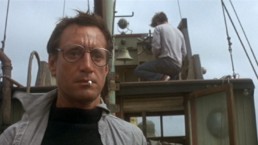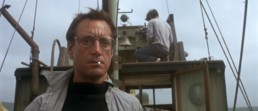Revisiting ‘Jaws’: What Modern Summer Blockbusters Should Learn From the Original
For years, I passively took the old adage that Jaws represented the birth of the modern blockbuster at face value, never considering that the film’s impact was anything beyond financial. Due to its massive box office success, Hollywood took note and launched us into an enduring era of bloated budgets and event pictures that continues stronger than ever today. Re-watching the film again for its recent 40-year anniversary, I was more interested to note how the perfectly realized storytelling elements of Jaws have become the template for modern big-budget filmmaking. READ MORE...
For years, I passively took the old adage that Jaws represented the birth of the modern blockbuster at face value, never considering that the film’s impact was anything beyond financial. Due to its massive box office success, Hollywood took note and launched us into an enduring era of bloated budgets and event pictures that continues stronger than ever today. Re-watching the film again for its recent 40-year anniversary, I was more interested to note how the perfectly realized storytelling elements of Jaws have become the template for modern big-budget filmmaking. Like an imposing fin cutting through still water, the unique cinematic achievements of Jaws have rippled outward for so long that most of us are hardly aware of the effects anymore. But they are there, and here they are…
A New Kind of Horror
Though frequently labeled as horror, Jaws is much more than that. A standard horror film might have sparked a trend – as Halloween and The Exorcist have both done, to name a couple – but would never have such a profound effect on the studio system four decades after its release. It does admittedly have its share of darkened set pieces and even jump scares, and it spends a good chunk of its time building up its near-unstoppable villain the way another film might build up the mythology of a vampire or werewolf. Jaws hasn’t endured for so long after its initial success merely on the strength of its scares and its monster but, I’d argue, thanks to its characters and deft juggling of tone. A horror film’s final minutes are filled with dread and hopelessness, while those of Jaws are instead strangely hopeful. Aboard the rusty little boat, the three men come together despite disparate personalities to work toward a common goal as John Williams’ triumphant score swells in the background. There’s no hopelessness here, but an unexpected sense of awe and adventure that belies the fact that one of those three men will soon be messily devoured by a great white—we’ll get to that later though.
It Starts With the Script
John Williams can’t take all the credit, when in fact Peter Benchley and Carl Gottlieb’s screenplay deserves most of it. The script finds economic ways to build up the setting of Amity Island as well as the journeys of the three main characters, who only truly take center stage in the film’s thrilling second half. Brody (Roy Scheider), Quint (Robert Shaw) and Hooper (Richard Dreyfuss) are all brilliantly written and cast. They fit into neat archetypes—family man, burly blue-collar fisherman, pretentious young scientist—without ever feeling like stereotypes, thanks in part to the skilled actors who play each part. All three are eventually driven by their common goal, but the script and direction distinguishes them and makes each motivated to kill the shark for their own reasons—Quint’s bone-chilling monologue being the most famous of the lot. There is time for other characters in the film’s two hour runtime, but the focus is placed squarely on them and the shark, building up the threat and their connections to it, so that once the film reaches its climax, there’s no need for the action to come to a halt so Brody can announce, “Hey, I’ve faced my fear of water now.” Many movies would make that exact mistake.
The Avengers, Adrift at Sea
Here, in the clashing and eventual bonding of strong personalities, in the wise-cracking while staring down impending doom, is the blueprint for modern blockbusters such as The Avengers. The Avengers doesn’t have the visual panache of Jaws—few films do, but we’ll get to that too—but it succeeds thanks to its hero’s personalities, courtesy of director Joss Whedon, whose TV shows have always soared on their characters instead of their high concepts. Like so many other blockbusters, all Marvel films can be similarly traced back to Jaws, where Spielberg perfected a guide for future generations on how a film can be both fun and horrifying at once. To their detriment, Marvel tends to complicate their plotlines with extraneous characters and set-pieces, and they’ve yet to craft a villain as memorably terrifying as that damn shark.
Jurassic World’s Jarring Waters
More recently, Jurassic World—of all films that should have learned from Spielberg!—failed for neglecting to apply any worthwhile lessons from Jaws. There’s little time for that indescribable Spielbergian sense of awe in the film, even if it does once lazily employ John Williams’ original Jurassic Park theme. Indeed, there’s little time for anything really in such an overstuffed blockbuster. So many characters share the screen time with little to no effect. Director Colin Trevorrow and the other writers created a film centered on roughly a dozen badly telegraphed stereotypes when crafting three characters anywhere near as interesting as Hooper, Quint and Brody would have sufficed.
Much has been made of the most gruesome death in Jurassic World as a moment where the film went too far, but what of (spoilers for a 40-year-old film) Quint’s death? Spielberg certainly doesn’t spare us the grisly details, as there is indeed far more blood in his encounter with the shark than in Zara’s with the pteranodons. The difference is that Quint’s death serves a narrative purpose and makes sense for the character—we understand his long-held vendetta with sharks, and we know he has something of a death wish, so it’s all but inevitable. Meanwhile, Zara’s death is a lengthy one for a minor character, not so much intended to tug heartstrings or fulfill any journey but to make full use of the CGI pteranodons. Without reason, the death just feels mean.
The death scene in Jaws, perhaps most importantly of all, is part of a series of escalations. Jaws is maybe the purest example for the virtues of escalation in film. Aware of the visual shortcomings of his animatronic shark, Spielberg was careful to keep shots of the monster few and far between, starting from the simple image of a fin flapping above water and ending with the titular jaws chewing through Quint’s torso. There’s a logic to the film’s progression that creates mounting tension, as Brody, our chief protagonist, is drawn finally into a direct face-off with the shark. Compare that to Jurassic World, wherein the Indominus Rex is shown early and frequently but without any sense of scale, and the characters mostly exist to be put in harm’s way and eventually unleash the t-rex from the first film.
Cinematography of the Sea
Upon rewatch, one facet of Jaws stands out as a relic, something that unfortunately hasn’t endured into modern blockbusters – its cinematography. Spielberg uses energetic editing techniques as well as he uses long takes, deftly staging conversations about closing down the beach so they become as visually interesting as each set-piece. There’s plenty of dialogue in the film, but there’s just as much blocking, blocking that creates interesting power dynamics within shots and speaks to how the characters interact with each other and the community around them. In terms of editing, just look at the second shark attack scene on the beach, where Brody watches the beach for any sign of trouble and Spielberg’s camera takes inventory of each moving part in the scene to create tension and put us into the character’s mindset. Such nimble editing and visually striking shots remain a rarity today.
The First Blockbuster
As media ages, it can begin to lose its luster. To its credit, Jaws has lost just about none of its original impact, though killer sharks might not seem so novel now as they were in the mid-70s. The storytelling, the cinematography, and the plain but effective character work remains as brilliantly realized today as it did forty years ago. In fact, in some respects it seems even more impressive, as so many blockbusters since have tried to approximate its magical mixture of horror, humor and adventure without nearly as much success. Many future films will continue to learn from the primo storytelling of Jaws, but I wouldn’t be surprised if the first modern blockbuster remains the best.
Jeff Rindskopf
Jeff Rindskopf is a contributing writer for CINEMACY.








